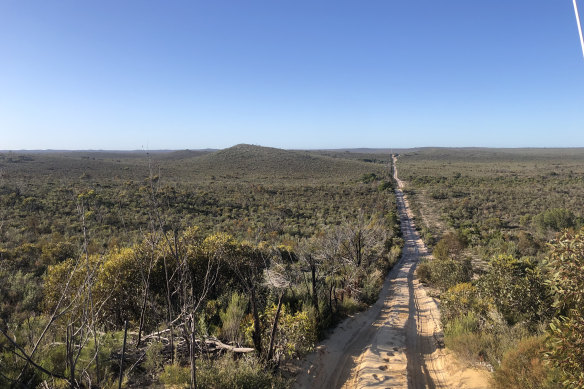
The call had been recorded by a volunteer from Bendigo. Disability support worker Lachy Wild, 24, was one of 58 volunteers who had given two weeks of their time to help Verdon search the remote Big Desert Wilderness Park for 10 rare bird species.
Before this recording, the white-bellied whipbird was believed to be extinct in Victoria, with only a tiny population in South Australia.
The lesser known cousin of the eastern whip bird, whose characteristic whip-crack call is heard throughout the moist forests of eastern Australia, the white-bellied whipbird lives in desert heath land in the state’s north-west.
With dark olive-brown feathers and white marks on its throat and belly, the white-bellied whipbird forages mostly on the ground and moves low through the low foliage, calling only when it chooses to be detected.
Unlike its better-known cousin, its call does not include a “whip crack” note, but rather a “cartwheeling” cry that you can listen to through the audio player in this story.
This call has more than 70 different phrases, which can make it difficult for even seasoned birders to identify.

Dr Simon Verdon (third from left), volunteers and researchers on a wilderness trip to search for rare birds.
“It’s incredibly sneaky, as are a lot of the Mallee birds, that’s why it has had long intervals without detection,” Verdon said.
Through La Trobe University, Verdon took groups of volunteers – the youngest was 16 and the oldest 72 – on nine-day camping trips where they rose before the sun and spent each day walking solo through the scrub with a tablet in their hands, trying to capture the sound or sight of rare birds such as the Mallee emu wren or red-lored whistler.
One night, as everyone sat around the campfire, Wild told Verdon he’d heard a strange bird call and recorded it. It was the white-bellied whipbird.
They returned to the location every day after that for weeks, but didn’t hear it call again.

The Big Desert Wilderness Park near Nhill, in north west Victoria.
The surveys had other positive findings, revealing that red-lored whistler and emu wrens had much greater populations than estimated.
Verdon and the volunteers plan to return next spring and search more thoroughly, with the data being used establish what kind of fire regimes should be used to promote bird habitat.
Loading
Birds living in arid desert areas in south-eastern Australia have found the recent wet weather very beneficial, after suffering through years of drought and heat that greatly reduced their food supply.
Get to the heart of what’s happening with climate change and the environment.
Our fortnightly Environment newsletter brings you the news, the issues and the solutions.
Sign up here.









 Add Category
Add Category